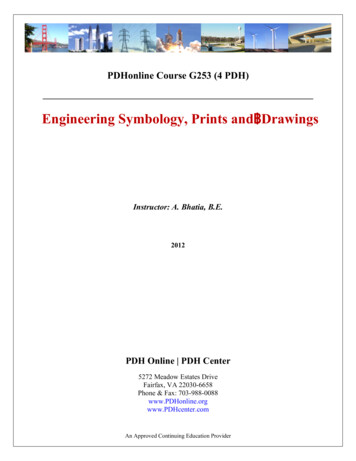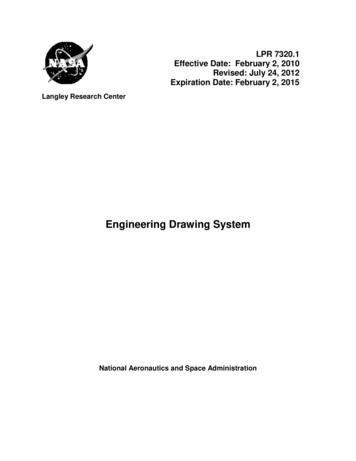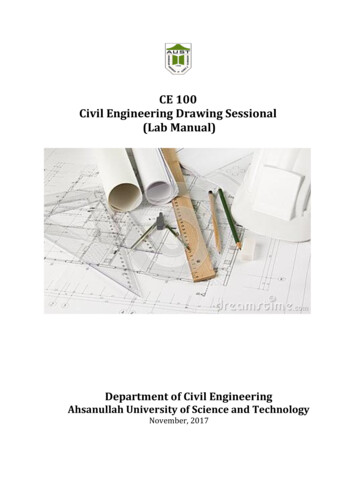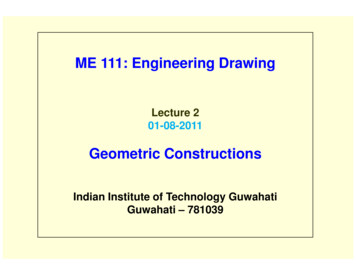
Transcription
ME 111: Engineering DrawingLecture 201-08-2011Geometric ConstructionsIndian Institute of Technology GuwahatiGuwahati – 781039
Geometric Construction Construction of primitive geometricforms (points, lines and planes etc.)that serve as the building blocks formore complicated geometric shapes. Defining the position of the object inspace
Lines and Planes
Solids
Curved surfaces
Primitive geometric forms Point Line Plane Solid etc
The basic 2-D geometric primitives, from whichother more complex geometric forms arederived.Points,Lines,Circles, andArcs.
PointA theoretical location that has neitherwidth, height, nor depth.Describes exact location in space.A point is represented in technical drawingas a small cross made of dashes that areapproximately 3 mm long.
A point is used to mark the locations of centersand loci, the intersection ends, middle of entities.
LineA geometric primitive that has length anddirection, but no thickness.It may be straight, curved or a combination ofthese.Lines also have important relationship orconditions, such as parallel, intersecting, andtangent.Lines – specific length and non-specific length.Ray – Straight line that extends to infinity froma specified point.
Relationship of one line to another line or arc
Bisecting a line
Dividing a line into equal partsSteps: Draw a line MO at any convenient angle (preferably an acuteangle) from point M. From M and along MO, cut off with a divider equal divisions(say three) of any convenient length. Draw a line joining RN. Draw lines parallel to RN through the remaining points on lineMO. The intersection of these lines with line MN will divide theline into (three) equal parts.
Planar tangent condition exists when twogeometric forms meet at a single point and donot intersect.
Locating tangent points on circle and arcs
Drawing an arc tangent to a given point on the lineSteps Given line AB andtangentpointT.Constructalineperpendicular to line ABand through point T. Locate the center of thearc by making the radiuson the perpendicularline. Put the point of thecompass at the center ofthe arc, set the compassfor the radius of the arc,and draw the arc whichwill be tangent to the linethrough the point T.
Drawing an arc, tangent to two lines
Drawing an arc, tangent to a line and an arc(a) that do not intersect(b) that intersect
Construction of Regular Polygon of given length AB(A)(B)Draw a line of length AB. With A as centre and radius AB, draw asemicircle.With the divider, divide the semicircle into the number of sides of thepolygon.Draw a line joining A with the second division-point 2.
Construction of Regular Polygon of given length AB .(A)(B)The perpendicular bisectors of A2 and AB meet at O. Draw a circlewith centre O and radius OA. With length A2, mark points F, E, D & Con the circumferences starting from 2 (Inscribe circle method)With centre B and radius AB draw an arc cutting the line A6 producedat C. Repeat this for other points D, E & F (Arc method)
General method of drawing any polygonDraw AB given length of polygonAt B, Draw BP perpendicular & ABDraw Straight line APWith center B and radius AB, draw arc AP.The perpendicular bisector of AB meets st.line AP and arc AP in 4 and 6 respectively.Draw circles with centers as 4, 5,&6 andradii as 4B, 5B, & 6B and inscribe a square,pentagon, & hexagon in the respectivecircles.Mark point 7, 8, etc with 6-7,7-8,etc. 4-5 toget the centers of circles of heptagon andoctagon, etc.
Inscribe a circle inside a regular polygon Bisectany twoadjacentinternalanglesofthepolygon. Fromtheintersectionofthese lines, draw aperpendiculartoany one side of thepolygon (say OP). With OP as radius,draw the circle withO as center.
Inscribe a regular polygon of any number of sides(say n 5), in a circleDraw the circle with diameterAB.Divide AB in to “n” equal partsNumber them.With center A & B and radiusAB, draw arcs to intersect at P.Draw line P2 and produce it tomeet the circle at C.AC is the length of the side ofthe polygon.
Inside a regular polygon, draw the same number of equalcircles as the side of the polygon, each circle touchingone side of the polygon and two of the other circles.Draw bisectors of allthe angles of thepolygon, meeting at O,thusdividingthepolygon into the samenumber of triangles.Ineachtriangleinscribe a circle.
Inside a regular polygon, draw the same number ofequal circles as the side of the polygon, each circletouching two adjacent sides of the polygon and two ofthe other circles.Draw the perpendicularbisectors of the sides ofthe polygon to obtainsamenumberofquadrilateralsasthenumber of sides of thepolygon.Inscribe a circle insideeach quadrilateral.
To draw a circle touching three lines inclined toeach other but not forming a triangle.Let AB, BC, and AD bethe lines.Draw bisectors of thetwo angles, intersectingat O.FromOdrawaperpendicular to any oneline intersecting it at P.With O as center and OPas radius draw thedesired circle.
Outside a regular polygon, draw the same number ofequal circles as the side of the polygon, each circletouching one side of the polygon and two of the othercircles.Draw bisectors of twoadjacent angles andproduce them outsidethe polygon.Draw a circle touchingtheextendedbisectors and the sideAB (in this case) andrepeat the same forother sides.
Construction of an arc tangent of given radius to two givenarcs Given - Arcs of radii M and N. Draw an arc of radius AB units which istangent to both the given arcs. Centers of the given arcs are inside therequired tangent arc.Steps:From centers C and D of thegiven arcs, draw constructionarcs of radii (AB – M) and (AB N), respectively.With the intersection point asthe center, draw an arc of radiusAB.This arc will be tangent to thetwo given arcs.Locate the tangent points T1 andT2.
Construction of line tangents to two circles (Open belt)Given: Circles of radii R1 and R with centers O and P, respectively.Steps:With P as center and a radiusequal to (R-R1) draw an arc.Locate the midpoint of OP asperpendicular bisector of OP as“M”.With M as centre and Mo asradius draw a semicircle.Locate the intersection point Tbetween the semicircle and thecircle with radius (R-R1).draw a line PT and extend it to locate T1.Draw OT2 parallel to PT1.The line T1 to T2 is the required tangent
Construction of line tangents to two circles (crossed belt)Given: Two circles of radii R1 and R with centers O and P, respectively.Steps:Using P as a center and aradius equal to (R R1) drawan arc.Through O draw a tangent tothis arc.Draw a line PT cutting thecircle at T1Through O draw a line OT2parallel to PT1.The line T1T2 is the requiredtangent.
8/8/201131
Dividing a line into equal parts Steps: Draw a line MO at any convenient angle (preferably an acute angle) from point M. From M and along MO, cut off with a divider equal divisions (say three) of any convenient length. Draw a line joining RN. Draw lines parallel to RN through the remaining points on line MO. The intersection of these lines with line MN will divide the



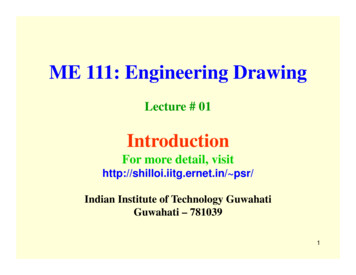
![Engineering Graphics Essentials [4th Edition]](/img/13/978-1-58503-610-3-1.jpg)


